Covid-19, the drop in the bucket?
Demonstrations and crisis in Hong Kong (a key platform for wines in Asia) in 2019, Brexit, US sanctions (Trump taxes) and now Covid-19: the international trade news of recent months has been anything but dull, and the wine industry, a major exporter, is bound to suffer the consequences.
Carole Maurel, University of Montpellier
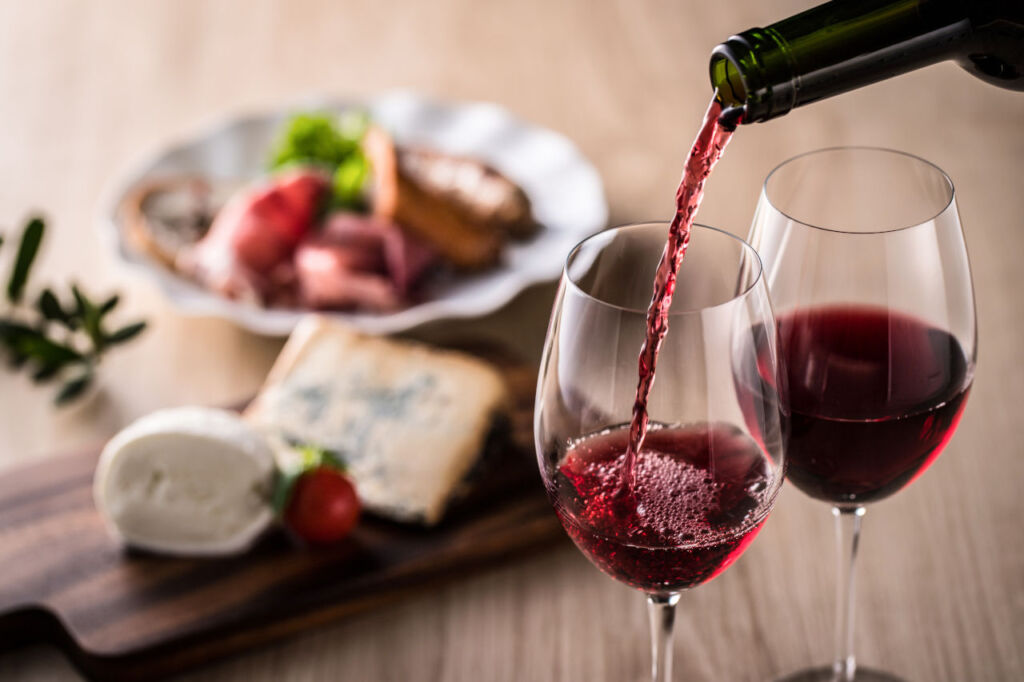
The wine market has been through many crises in the past, and has shown itself to be resilient. However, according to forecasts by IWSR, global wine sales could fall by 13% in 2020 as a result of the current crisis, demonstrating a more violent effect than during the 2008 financial crisis.
These cyclical difficulties are generating a high level of uncertainty for the players, many of whom are small and medium-sized exporters, and exacerbating certain structural difficulties that the players were still managing to contain before Covid-19.
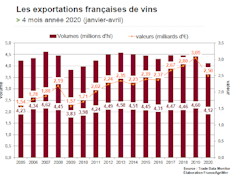
note de conjoncture de FranceAgrimer
FranceAgrimer's latest conjuncture note (July 2020) confirms the downward trend in French exports over the first 4 months of 2020 (-16% in volume and -36% in value compared with April 2019) across all wine categories, with a sharper downturn for Champagne.
Here's a reminder of France's world ranking in 2019:3rd largest vineyard area,2nd largest producer and consumer,3rd largest exporter by volume and, above all,1st largest exporter by value, ahead of Italy and Spain.
So, unfortunately, the current situation is a case in point of the impact of the environment on the export performance and health of wine companies, and the need to encourage the resumption of trade relations and initiatives to develop and promote sales.
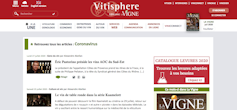
Website
In view of this unprecedented situation, we have analyzed the content of 238 articles extracted using the search engine of Vitisphère, the information, networking and specialized services portal dedicated to "vine and wine" professionals, over the period from March1, 2020 to July 26, 2020.
Using a dynamic approach, the aim was to take stock of the impact of the current health crisis on exporting companies in the French wine sector, as well as the initiatives and reactions of players to this crisis. Here are some of the highlights of our study over the past five months.
International and domestic sales at half-mast
As a direct consequence of the confinement and closure of borders - from China in January to Europe in February-March and the American continent in March - international activity came to a standstill during this period. This is borne out by the many postponements of international trade shows to summer 2020 or even 2021.
These events are essential to the commercial development of companies in the sector, and their postponement is a handicap to their international activity, even if innovative initiatives have been developed with online trade shows. These postponements are synonymous with a drop in cash flow, and missed opportunities to develop and maintain networks with both French and foreign customers.
Another sign that international activity has ground to a halt is the blockage of the logistics chain: ports saturated, port and airport activity at a standstill.
Similarly, the confinement and closure of borders has meant that sales forces have had to stop moving around, particularly for exports, and have been replaced by telecommuting, which is necessary to maintain business relations at a distance.
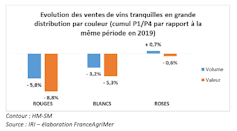
IRI for FranceAgriMer-CNIV
In addition to this international setback, the health crisis has led to a drop in consumption and changes in the domestic market: the failure of spring wine fairs in supermarkets, and the suspension of business in cafés, hotels and restaurants (CHR) and wine tourism.
Also read:
What Covid-19 reveals about the world's wine-drinking cultures
FranceAgrimer's economic outlook confirms the downturn in Appellations d'Origine Contrôlée (AOCs), the maintenance of Protected Geographical Indications (PGIs) and the sharp rise in Bag-in-Box sales.
A sharper drop is expected in the high-end segments, due in particular to the closure of CHRs and convivial occasions prevented by confinement. However, the effects on industry players will vary according to two factors: the level of dependence on these channels, and the situation of the production region prior to the crisis.
In fact, private wineries seem to be more affected than cooperative wineries, due to their heavy reliance on cellar sales, CHR and wine tourism, in addition to the slowdown in exports.
In Bordeaux, for example, this crisis has exacerbated the difficulties encountered by the industry, which has been suffering from a slowdown in domestic and Chinese consumption over the past 2 years, and is already facing structural overproduction due to the changing wine profiles demanded and the environmental shift to be made, not to mention the numerous climatic hazards of this year 2020.
The rise of online sales
At the beginning of March, journalists were already speculating that some of the consumption lost abroad would be transferred to the domestic market, and that this would be an opportunity for e-commerce (confirmed byIRI research showing a 179% rise in online sales over March-April).
In addition, this confinement has been an opportunity for some winegrowers to innovate and launch their own online sales site, enabling certain shipments in France and Europe. Others have launched home delivery or "click and collect" at the winery.
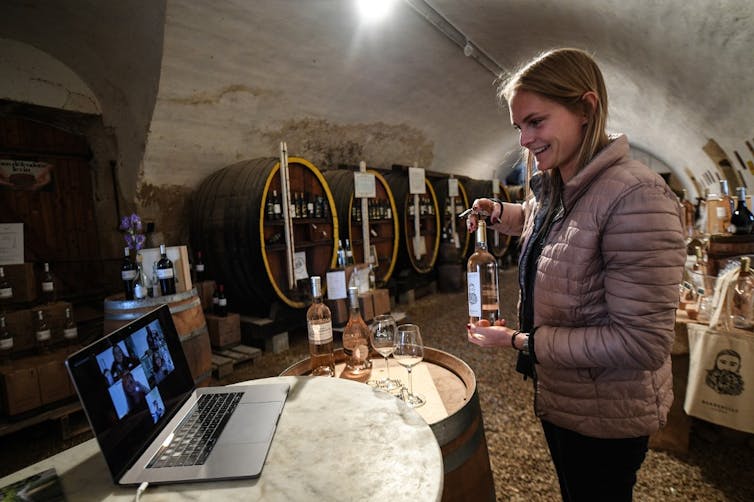
Anne-Christine Poujoulat/AFP
The same upward trend can be seen in auctions. In Hong Kong (the world's leading venue for online wine auctions), for example, an increase in online sales was observed as early as March 2020, replacing live auctions. It remains to be seen whether these trends will continue to develop over the coming months.
Surplus stocks cause concern
Against this backdrop of declining outlets for wine sales in France and abroad, there is one catalyst on everyone's mind: surplus stocks (estimated at 3 million hectolitres by the industry).
Inventories are an essential part of the operating cycle for companies in this sector, and make a major contribution to cash flow requirements.
Falling sales, lower yields, climatic hazards - all these factors upset the balance of the industry's inventory. The importance of these factors for the long-term survival of these companies is now clear.
This is why the entire industry has been working with the European Union, the French government, the regions and the banks over the past 5 months to obtain measures and aid to manage these surplus stocks, with the 2020 harvest in sight, for which storage capacity must be freed up.
Crisis distillation and private storage were at the heart of the discussions, alongside requests for exemptions from charges for loss of business, and aid for promotion and marketing.

Vitisphère website
The fact remains that not all players and regions have the same needs in terms of aid - the Bordeaux region and Languedoc having a greater need for distillation (they represent 60% of requests) than regions such as Champagne, Burgundy or Alsace, for example.
Other complementary measures are being studied, such as individual complementary volumes, interprofessional reserves and the possibility of increasing the proportion of 2019 vintage in 2020.
In view of climate change and the likelihood of further crises in the future, it seems essential to think about a toolbox for managing these downward (in the event of a low harvest, for example) and upward variations in wine inventories, which vary the financing requirements and operational risk of businesses and threaten their survival.
This toolbox will have to take into account the diversity of situations and profiles of the players involved, because this crisis shows us once again that the wine industry has many faces, and that a single, generalized solution is not appropriate.
Lastly, while for some the current crisis has provided an opportunity to show solidarity (donations of alcohol to make hydroalcoholic gel, charity sales, promotion of wine tourism), the period is above all an opportunity to reflect on the future, company strategy and projects.
To bounce back, the wine industry has no choice but to draw the consequences of the trends revealed during the crisis: corporate social responsibility, online sales, the development of bag-in-box in the on-trade to reduce the carbon footprint, etc. These are just some of the challenges facing the French wine industry and its long-term survival in this period of uncertainty.![]()
Carole Maurel, Lecturer in corporate finance and international management, University of Montpellier
This article is republished from The Conversation under a Creative Commons license. Read theoriginal article.